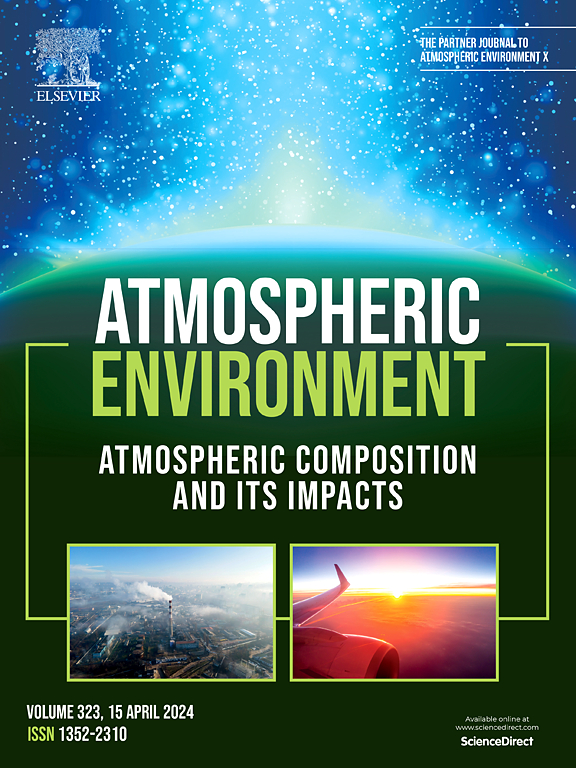Spectroscopic and chemical compositional analysis of the atmospheric aerosols in urban and rural tropical environment of southern India
IF 3.7
2区 环境科学与生态学
Q2 ENVIRONMENTAL SCIENCES
引用次数: 0
Abstract
This study provides a comprehensive characterization of atmospheric aerosols collected from Gadanki (13.5°N, 79.2°E, a rural background) and Hyderabad (17.5°N, 78.6°E, an urban location), marking the first detailed analysis of aerosol particles in these contrasting environments in southern peninsular India. Aerosol particulate matter (PM) samples, spanning different aerodynamic size ranges (10 μm, 2.5 μm, and 1.4 μm), were analyzed spectroscopically to determine the molecular structure of the chemical species. Both organic compounds (hydrocarbons, carbonaceous species, and amines) and inorganic species (ammonium sulfates/nitrates, clay minerals, gypsum, calcium carbonate, kaolinite, and metal-oxygen bonds) were identified. The urban PM exhibited higher carbon content, while rural aerosols showed a greater oxygen ratio, as confirmed by Energy-dispersive X-ray spectroscopy (EDX). Metal ions such as silicon (1.46–13.63 %), aluminium (0.34–5.72 %), sodium (0.61–3.99 %), calcium (0.14–1.5 %), iron (0.08–1.07 %), and zinc (0.06–0.81 %) were attributed to sources including vehicular emissions and wind-blown dust. Scanning Electron Microscopy (SEM) revealed that the particles were irregularly shaped and aggregated. Ultraviolet–visible (UV–Vis) spectroscopy revealed strong UV absorption and high transparency (∼99 %) in the visible range, with optical band gaps of ∼5.6 eV and 5.8 eV for Hyderabad and Gadanki, respectively, indicating their non-conducting nature. This study provides critical insights into the aerosol composition and behavior in tropical urban and rural locations, with important implications for air quality management and climate modeling.

印度南部热带地区城乡大气气溶胶的光谱和化学成分分析
本研究提供了从Gadanki(13.5°N, 79.2°E,农村背景)和Hyderabad(17.5°N, 78.6°E,城市位置)收集的大气气溶胶的综合特征,标志着在印度半岛南部这些对比环境中首次详细分析气溶胶颗粒。对不同气动尺寸范围(10 μm、2.5 μm和1.4 μm)的气溶胶颗粒物(PM)样品进行了光谱分析,以确定化学物质的分子结构。有机化合物(碳氢化合物、碳质物质和胺类)和无机物质(硫酸铵/硝酸铵、粘土矿物、石膏、碳酸钙、高岭石和金属-氧键)都被鉴定出来。能量色散x射线光谱(EDX)证实,城市PM的碳含量较高,而农村气溶胶的氧含量较高。硅(1.46 - 13.63%)、铝(0.34 - 5.72%)、钠(0.61 - 3.99%)、钙(0.14 - 1.5%)、铁(0.08 - 1.07%)、锌(0.06 - 0.81%)等金属离子的来源包括汽车尾气和风尘。扫描电子显微镜(SEM)显示,颗粒形状不规则,聚集。紫外-可见(UV - vis)光谱显示,海得拉巴和加丹基的光带隙分别为5.6 eV和5.8 eV,在可见光范围内具有强紫外吸收和高透明度(~ 99%),表明它们的非导电性质。这项研究为热带城市和农村地区的气溶胶组成和行为提供了重要的见解,对空气质量管理和气候模型具有重要意义。
本文章由计算机程序翻译,如有差异,请以英文原文为准。
求助全文
约1分钟内获得全文
求助全文
来源期刊

Atmospheric Environment
环境科学-环境科学
CiteScore
9.40
自引率
8.00%
发文量
458
审稿时长
53 days
期刊介绍:
Atmospheric Environment has an open access mirror journal Atmospheric Environment: X, sharing the same aims and scope, editorial team, submission system and rigorous peer review.
Atmospheric Environment is the international journal for scientists in different disciplines related to atmospheric composition and its impacts. The journal publishes scientific articles with atmospheric relevance of emissions and depositions of gaseous and particulate compounds, chemical processes and physical effects in the atmosphere, as well as impacts of the changing atmospheric composition on human health, air quality, climate change, and ecosystems.
 求助内容:
求助内容: 应助结果提醒方式:
应助结果提醒方式:


